calsfoundation@cals.org
Amphibians
Arkansas has within its borders a modest assemblage of salamanders, frogs, and toads, which are taxonomically grouped in the class Amphibia and, therefore, are commonly called amphibians. Amphibians were the first tetrapods (four-legged vertebrates) to walk on land, having come from an early-evolving group of lobe-finned fishes nearly 360 million years ago. Today’s amphibians possess a mostly bony skeleton with a strong “backbone” comprising a series of interlocking vertebrae. Salamanders are termed caudates because they possess a tail in both the juvenile and adult forms, whereas frogs and toads (collectively called anurans) lack tails as adults even though the larvae (tadpoles) possess them. The study of amphibians has been traditionally linked with the study of reptiles in the professional field called herpetology.
Amphibians generally possess moist skin, and many forms have webbed feet. Some species, however, lack one or both pairs of limbs. Amphibian skin contains several types of glands; some glands prevent dehydration through the secretion of mucus, while others secrete toxins (poisons), making many amphibians unpalatable to most predators. Still other skin glands found in some male salamanders exude secretions that serve to stimulate the females during courtship and mating activities. Skin glands may be aggregated into raised areas, warty patches, or even enlarged glandular protuberances.
Many amphibians exhibit dual life cycles; i.e., they have an aquatic larval stage and terrestrial juvenile and adult stages. Consequently, most amphibians rely on some type of aquatic medium in which to lay their eggs, and no parental care is generally provided to these offspring. Many salamanders and anurans deposit their eggs in globular egg clusters (egg masses), which can be singly or communally deposited in ponds or pools of water. Egg masses are often attached to emergent vegetation or to various substrate objects, such as downed tree limbs and submerged leaf litter. In most anurans, the hatching of eggs into tadpoles is followed by a rapid feeding and growth phase that culminates with metamorphosis (transformation in body form) and exit from the water to begin a mostly terrestrial existence. Although the primary mode of reproduction in amphibians is aquatic egg-laying, some species of salamanders lay eggs in grape-like clusters in humid and often well-secluded terrestrial niches. These females will usually remain close to the developing embryos and actually brood them until hatching. Another unusual reproductive mode consisting of highly evolved parental care is exhibited by a few tropical frogs. These frogs possess intricate brooding chambers or skin pouches on their bodies in which they rear their young. Finally, a small number of amphibians has adapted to viviparity, or giving birth to live young.
Although either internal or external gills serve as the mechanism for gas exchange in all larval amphibians, some adult salamanders retain this juvenile character state. Several permanently aquatic salamanders utilize external gills throughout their lifetimes. The skin serves as the primary means of gas exchange in lungless salamanders.
An amphibian’s body temperature fluctuates according to ambient or surrounding environmental conditions. Though it is far from ideal, the term “cold-blooded” is still often used to describe amphibians. Today, the more appropriate term poikilothermic generally applies to an animal whose body temperature varies depending upon the environment (e.g., fish, amphibians, and reptiles), whereas homeothermic is the contrasting term that refers to an organism with a uniform body temperature (e.g., birds and mammals).
Worldwide, there are over 358 described species of salamanders, over 3,994 described species of frogs and toads, and around 163 described species of caecilians. Each year, an ever-increasing number of new species within each group is named, especially tropical anurans. In Arkansas, there are approximately thirty described species of salamanders and twenty-nine species of frogs and toads.
Salamanders
Arkansas’s salamanders vary greatly in adult body size and body proportions, ranging from the slender and diminutive dwarf salamander (Eurycea quadridigitata), which as an adult rarely exceeds three inches in total length and is found in the southern regions of the state, to the elongated three-toed amphiuma (Amphiuma tridactylum), which can grow to over three feet and is found mostly in the Delta. The Ozark hellbender (Cryptobranchus alleganiensis), a large aquatic salamander, has a robust body form and has a very limited distribution in several northern counties, whereas the western lesser siren (Siren intermedia) has a tube-shaped slender body similar to that of the three-toed amphiuma. It occurs primarily in the eastern and southern regions of the state. Four Arkansas salamanders are permanently aquatic: the Ozark hellbender, the three-toed amphiuma, the Red River mudpuppy (Necturus maculosus), and the western lesser siren. The latter two of these possess permanent fleshy external gills. A number of Arkansas’s species are semi-aquatic and dwell in or around the shorelines of creeks and small streams, along springs and in springheads, and in caves. One such species is the colorful cave salamander (Eurycea lucifuga), which has a reddish orange back with small black spots. It occurs north of the Arkansas River in the Ozarks. Another is the Ouachita dusky salamander (Desmognathus brimleyorum), which occurs primarily in the mountainous southwestern counties south of the Arkansas River. Local residents in the Ozark and Ouachita mountains sometimes mistake lizards, which are reptiles, for salamanders (or vice versa), often referring to the latter as “spring lizards.”
Some of the more commonly observed woodland salamanders are surface or near-the-surface dwellers. They occur in and under logs or beneath large rocks and boulders. The Ozark zig-zag salamander (Plethodon angusticlavius) and the western slimy salamander (Plethodon albagula) are two excellent examples. The former occurs only in the Ozark Mountains, whereas the latter is found throughout the Interior Highlands. What is most interesting about these two species and other members of the genus Plethodon is that they are lungless; oxygen-carbon dioxide exchange for respiration occurs solely through their skin and oral cavities.
Internal fertilization is the rule in nearly all Arkansas salamanders except the primitive Ozark hellbender and the unusual western lesser siren, which has no internal cloacal glands specifically related to reproduction. In Ozark hellbenders, external fertilization is similar to the method employed by fish; i.e., males spew milt onto eggs previously laid by females. The nesting chamber is commonly beneath a large riverine boulder or within a secluded crevice or rock cluster in a stream. Very little is known about actual egg-laying/courtship in Ozark hellbenders or about the breeding biology in the western lesser siren.
For those species that engage in internal fertilization, a somewhat elaborate courtship display involves the male depositing a sperm packet (spermatophore) onto the substrate (pond bottom in aquatic-breeding salamanders and terrestrial surface in other forms). He then leads the female into a position where her vent (anal region) hovers precisely over the spermatophore. She will then pick up the top of the spermatophore that contains the sperm with her cloacal lips. The sperm eventually move into sperm receptacle glands embedded inside the female’s cloaca. Here the sperm remain until fertilization occurs during egg laying. Females may retain sperm for several days to several weeks and sometimes several months.
In 2014, a new salamander species was discovered in Arkansas. The new species is a small, larviform paedomorph commonly known as the Ouachita streambed salamander (Eurycea subfluvicola). It has a highly restricted distribution, occurring only in a single stream that flows into Lake Catherine near Hot Springs (Garland County). At present, little is known about its life history or population size.
Anurans
Arkansas has one of the smallest frogs in the United States, the cricket frog (Acris crepitans); these tiny frogs live from one to two years and are still quite common in most regions of the Natural State. The largest frog, the American bullfrog (Rana catesbeiana), can be found in just about any aquatic habitat. Sometimes nature plays amazing tricks with the coloration in frogs. For instance, a typical American bullfrog has a body coloration that is various shades of green. In striking contrast are the leucistic and albino individuals of this species that are occasionally found. Leucistic animals are characterized by reduced amounts of pigmentation, whereas albinistic animals have a reduction in a specific pigment (melanin) in the skin.
Breeding in anurans can occur during any season although many species’ breeding cycles are tied to annual climatic or precipitation events. For example, the wood frog (Rana sylvatica), which occurs only in the Ozark Highlands region, has a breeding cycle timed to match heavy mid-to-late-winter rains. After the rain, wood frogs appear for just a few days and seem to be driven by a somewhat frantic need to breed. Ozarkian ponds may be overrun by hundreds to thousands of these frogs in what have been called “explosive breeding episodes.” The eastern spadefoot (Scaphiopus holbrookii) is a common but rarely seen Arkansas toad of the Delta that also relies on localized deluges during severe thunderstorms in its prime habitat of sandy soils. It is at this time that spadefoots exit from their burrows to breed in shallow pools. The larvae have evolved to have only a very brief duration in the tadpole stage, which is seldom longer than three weeks. Sandy soils tend to dry out quickly, and this species must complete its larval life stage rapidly. Unfortunately, the Illinois chorus frog (Pseudacris streckeri illinoensis) must also utilize the same small breeding pools in sandy habitats, and their larval stage can last three times as long as that of spadefoots. Thus, environmental changes due to agricultural perturbations have resulted in the near-to-complete annihilation of this species in Arkansas.
Threats to Amphibians
Arkansas has drained and filled over seventy percent of its pre-settlement wetlands, thus endangering numerous species of amphibians. Until recently, the loss of these wetlands had represented the greatest threat to amphibian survival. Currently, however, agricultural land management practices further add to this threat. For example, the removal of breeding depressions by the practice of precision-leveling agricultural fields in northeastern Arkansas has greatly reduced the number and size of Illinois chorus frog populations previously found there. The removal of trees along fence rows in the Delta also increases wind erosion and the drying out of available marginal habitats. Drought conditions in recent years, possibly brought upon the state by global warming, have also contributed to declining populations. Industrial development and suburban sprawl devours non-disturbed areas and, thus, takes away additional habitats and creates fragmented habitats, preventing optimal chances for breeding. Fortunately, no amphibian species currently known to occur in Arkansas has been extirpated (eliminated from within the state’s borders).
Providing and protecting optimal habitat for native amphibians to ensure their continued survival will require the combined efforts of Arkansas biologists, soil conservation officials, and landowners. Because most amphibians reproduce on an annual basis, it is imperative to consider the consequences of destroying any aquatic breeding sites. By creating vernal breeding ponds, restoring wetland areas, and managing land resources wisely to minimize aquatic pollution, all can share in the future of these animals. Prudent choices can truly make a critical difference to their continued existence.
For additional information:
Becker, Brian M. “Demographics, Sexual Dimorphism, and Ecological Aspects of Ambystoma annulatum (Ringed Salamander) in Northwest Arkansas, USA.” PhD diss., University of Arkansas, 2023. Online at https://scholarworks.uark.edu/etd/5140/ (accessed February 21, 2024).
Halloran, Kelly. “Population Dynamics of Ouachita Dusky Salamanders (Desmognathus brimleyorum) in a Managed Forest Landscape.” MS thesis, University of Arkansas, 2017. Online at https://scholarworks.uark.edu/etd/2578/ (accessed July 6, 2022).
Herps of Arkansas. http://www.herpsofarkansas.com/ (accessed September 22, 2021).
Kross, Chelsea Shannon. “Conservation and Population Ecology of the Imperiled Crawfish Frog (Lithobates areolatus) in Human-Altered Landscapes.” PhD diss., University of Arkansas, 2020. Online at https://scholarworks.uark.edu/etd/3791/ (accessed August 25, 2022).
Petranka, James W. Salamanders of the United States and Canada. Washington DC: Smithsonian Institution Press, 1998.
Trauth, Stanley E., Henry W. Robison, and Michael V. Plummer. The Amphibians and Reptiles of Arkansas. Fayetteville: University of Arkansas Press, 2004.
Zug, George R., Laurie J. Vitt, and Janalee P. Caldwell. Herpetology: An Introductory Biology of Amphibians and Reptiles. 2nd ed. New York: Academic Press, 2001.
Stanley E. Trauth
Arkansas State University
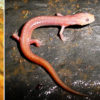 Grotto Salamander
Grotto Salamander Science and Technology
Science and Technology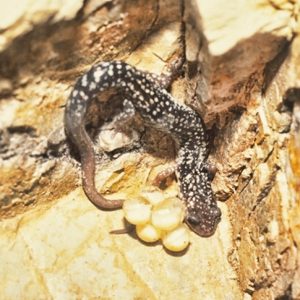 Caddo Mountain Salamander
Caddo Mountain Salamander 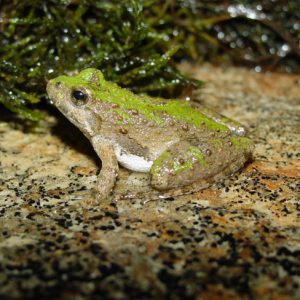 Cricket Frog
Cricket Frog 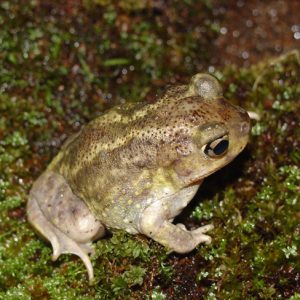 Eastern Spadefoot
Eastern Spadefoot  Fourche Mountain Salamander
Fourche Mountain Salamander  Gray Tree Frog
Gray Tree Frog 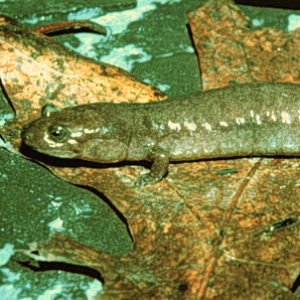 Ouachita Dusky Salamander
Ouachita Dusky Salamander 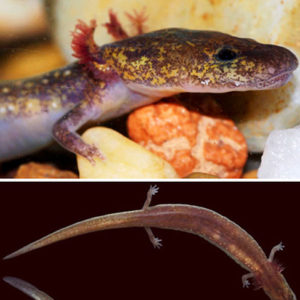 Ouachita Streambed Salamander
Ouachita Streambed Salamander 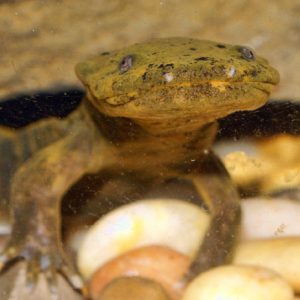 Ozark Hellbender
Ozark Hellbender 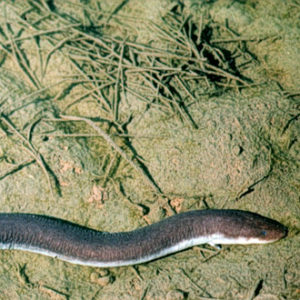 Three-toed Amphiuma
Three-toed Amphiuma 




Just found a slimy salamander in my backyard in Hot Springs Village.